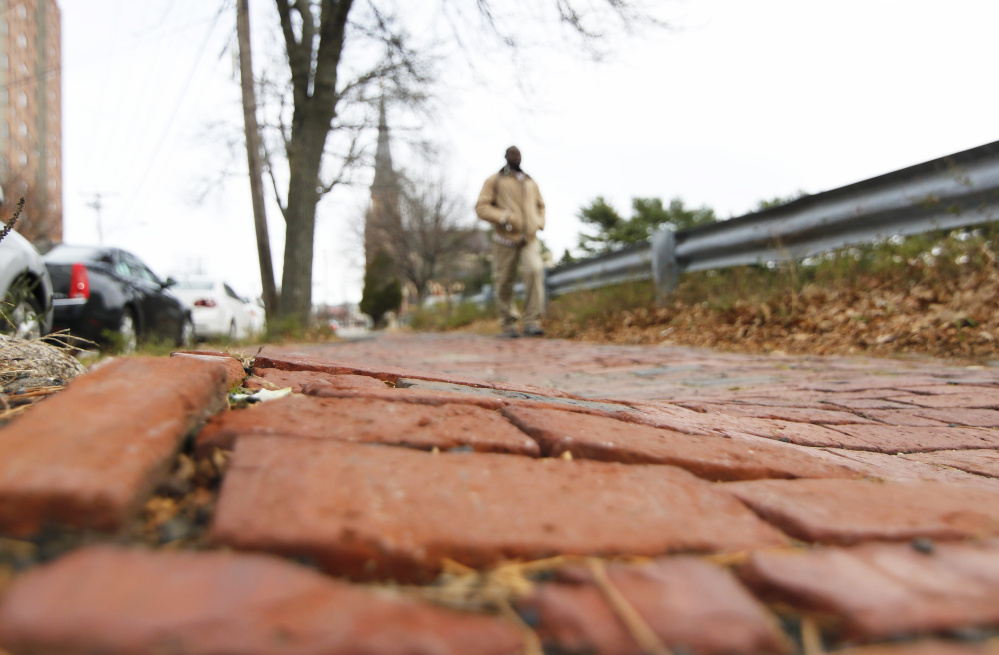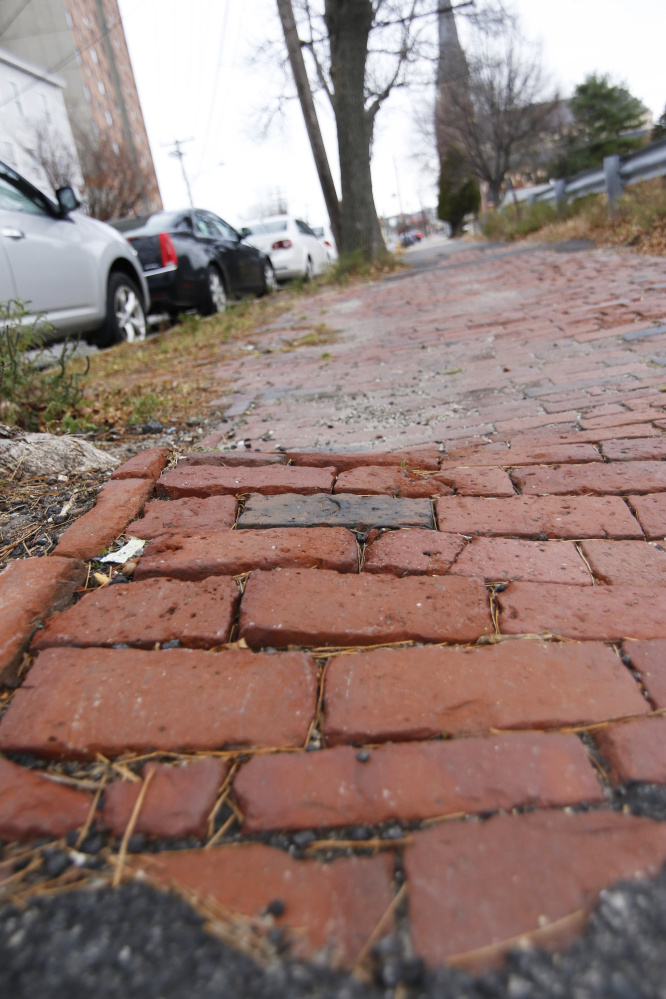One reason we study history is to learn from our mistakes, so we don’t repeat them. In Portland, we keep making the same mistake. We are literally tripping over history – and breaking limbs in the process.
The mistake I’m talking about is brick sidewalks.
They may have made sense in 1858, when Henry Wadsworth Longfellow celebrated his beloved Portland in verse as “the beautiful town that is seated by the sea.”
But they don’t make sense in 2015. They are treacherous year-round, and doubly so when coated with ice. They keep people in cars rather than choosing the healthier and more eco-friendly alternative of walking.
I’ve spoken to several city residents who fear walking in downtown Portland because they’re afraid they’ll fall on the bricks. That is a shame, especially when there are alternative sidewalk materials that keep a “historic” look without posing such a danger.
Here is what the Federal Highway Administration says about brick (and cobblestone) sidewalks:
“Although these surfaces are decorative, they increase the amount of work required for mobility. In addition, brick and cobblestone have inherent changes in level that are often tripping hazards. Alternatives to brick sidewalks include colored concrete stamped to look like brick, and asphalt or concrete paths with brick trim. Both alternatives preserve the decorative quality of brick but are easier for people with disabilities to negotiate.”
A policy approved by the Portland City Council five years ago requires brick sidewalks throughout the peninsula, and on a small number of other streets.
Hilary Bassett, executive director of Greater Portland Landmarks, describes brick sidewalks as “part of the personality of the city.” Her group advocates keeping them on all streets that now have them.
Judy Paolini also loves the way the brick sidewalks look, but adds, “I just wish there was a better brick product out there that wasn’t so dangerous.”
While rushing to a meeting last spring, Paolini tripped on an uneven brick and cobblestone sidewalk in the Old Port and fell face down, fortunately not hurting herself. Paolini was one of at least 30 residents who filed complaints about brick sidewalks during the past year on the city’s Fix It! Portland online portal.
Here’s another complaint, about an uneven brick sidewalk on Deering Street: “I was jogging and my foot came down on one of the sloped parts, and I ended up on crutches for a week with a sprained ankle.”
A quarter of the 120 Fix It! Portland complaints about sidewalks last year explicitly mentioned bricks as the culprit. Given the location of several other complaints, it is likely that they also involved brick sidewalks.
I was particularly interested in a complaint from 8 Arlington St., near Back Cove, because I lived at that address for 16 years. When we moved there in 1987, the brick sidewalk was like a mogul-filled ski slope. My daughter struggled to scale the bumps as she rode her tricycle around the block.
About a decade later, the city tore up the street to separate the storm and sewer pipes. I was thrilled. At last, I thought, we’d get a safe, concrete sidewalk.
Guess what? They installed another brick sidewalk.
The man who lives in my old house recently filed a complaint. “Tree roots have caused sidewalk to bulge in two location(s), and several bricks need replacing,” he reported. Talk about déjà vu!
During the recent Portland mayoral campaign, we heard a lot of concern about rising property taxes. Why do we waste money on brick sidewalks? According to the city, they cost $130 per square yard, compared to $100 per square yard for concrete.
As the Federal Highway Administration points out, brick sidewalks also require very skilled installers. The agency says they theoretically could last up to 40 years, the same amount of time as concrete. But that is not the case on Arlington or nearby Clifton Street, where many bricks laid less than 20 years ago are heaved up or gouged out.
The U.S. surgeon general recently issued a “call to action” encouraging Americans to walk as a way of getting more exercise. One of the big draws of Portland’s downtown is that it’s small enough to get around on foot. Why do we create hazards for pedestrians and discourage many from walking?
Maine has the oldest population of any state in the country. An effort is underway to create communities where elders can age in place. Whether they get around on foot, with walkers or in wheelchairs, they need safe sidewalks. Brick sidewalks are not safe. Why do we keep building them?
Jessica Grondin, Portland’s communications director, said the city tried using cement pavers as an alternative to brick about 15 years ago, and found that they did not hold up well.
New products have been developed since then. Portland should investigate the latest sidewalk technology.
Now that Portland has a new mayor and two new city councilors, let’s ask our leaders to revisit Portland’s sidewalk policy. The time is overdue to ditch the bricks and replace them with a safer alternative.
Shoshana Hoose is a freelance writer who bicycles in Greater Portland and beyond. Contact her at shoshanahoose@gmail.com.
Send questions/comments to the editors.




Success. Please wait for the page to reload. If the page does not reload within 5 seconds, please refresh the page.
Enter your email and password to access comments.
Hi, to comment on stories you must . This profile is in addition to your subscription and website login.
Already have a commenting profile? .
Invalid username/password.
Please check your email to confirm and complete your registration.
Only subscribers are eligible to post comments. Please subscribe or login first for digital access. Here’s why.
Use the form below to reset your password. When you've submitted your account email, we will send an email with a reset code.